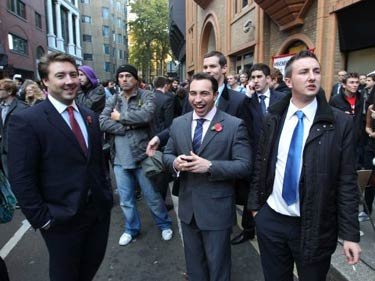
Bankers — The two-button suits, buttonless collars, and custom shirts really don’t look that well.
GSElevator, the cynic who earlier this year was offering advice to summer interns, is back at Business insider, with even more sartorial advice.
I find the millenial perspective interesting, though I frequently do not in the least agree. So, instead of quoting him, I will just comment and respond.
Shoes
Loafers are fine for casual wear, but for business? Especially for investment banking??
My own opinion is that, no, sonny, loafers have not really become appropriate. What has happened is that more tasteless ethnic louts confusedly think the high prices associated with Gucci loafers make them formal and appropriate.
Men walking around offices in loafers will strike the genuinely critical observer as adolescent.
For serious occasions, and banking is serious, a man ought to wear serious adult footwear, with laces.
‘
GSE has lots of money. He ought to get his shoes custom made.
He is right about using shoe trees, but I find his inclination to get his housekeeper to polish his shoes impressively self-entitled. My cleaning women, I think, would typically have either rebelled or done a poor job. I favor getting one’s shoes polished at a shoeshine stand at the station or one’s club.
One other note: Bostonians believe that only waiters swear black shoes. So in Boston, be sure to carefully match fine shades of brown or cordovan to one’s blue and grey suits. Since neither you nor I are actually from Boston, we cannot possibly do what an old school Bostonian would and wear brown shoes with a black suit.
————————
Socks
If GSE has seen some Brits running around flashing pink socks, he probably should be told that the proper term is “cerise,” and those gentlemen are subtly boasting about belonging to the Leander Club, the home away from home of aging crew jocks.
————————
Pants/Trousers
No cuffs on full weight formal woolen suits? God forbid! You omit cuffs on summer weight suits, on poplin, khaki, seersucker. But only spivs and ethnic gentlemen with more money than taste wear conventional suits without cuffs.
Pleats are entirely a matter of ephemeral fashion and individual taste.
If you don’t wear a belt, you will have difficulty carrying a handgun. Your trouser waistband will not provide adequate support. Besides, trousers without a belt buckle concealing the top closure look too informal.
————————
Belts/Suspenders
Obviously, no gentleman should ever wear a visible haberdasher’s logo on anything but a polo short (and, personally, I used to remove Rene LaCoste crocodiles with a razor blade when I was really hard-core).
I think all bespoke trousers ought to come with suspender buttons. I’d say that one ought to wear, in most cases, both a belt and suspenders: the belt purely ornamentally to complete the look of the trousers, and the braces for actual support.
————————
Shirts
In general, one should avoid white collared coloured shirts. Most men simply cannot pull them off. They are naturally expressive of vanity and excess. And they shout aloud: “I have been to a custom shirtmaker.”
I have my doubts about custom shirts in general. In most cases, they are not superior in fabric, tailoring, or even cost to good men’s off-the-peg shirts, but they are fussier. I have had shirts custom made, but I found that I actually don’t like tailored sleeves which closely hug the wrist, and I’m perfectly content with standard Oxford cloth white shirts from Brooks Brothers, J. Press, or Paul Stuart.
I tend to associate the precise shape of the collar and whether or not the shirt has a pocket with exactly which traditional men’s shop sold me the shirt.
Those of us who attended certain universities tend to wear button down collars in all but the most formal of diurnal circumstances. If one understands these things correctly, one understands that men’s style is timeless. There are no 1990s. There are no 2020s. If Cary Grant came to work at Goldman’s wearing the grey suit he was wearing in North by Northwest (1959), he’d look better than anyone else and he’d be perfectly in fashion.
I think cufflinks are excessive most days, and French cuffs too much trouble. But this sort of thing is within the realm of individual taste and expression. But, if you are going to wear cufflinks in the daytime, they had better be discreet and in careful good taste.
————————
Ties
You have to tie a Windsor knot if you are wearing a wide collar and/or if you happen to be using a thin tie. Very old neckties often lack good linings. Well-made contemporary neckties, on the other hand, typically form an excellent knot when tied simply in the four-in-hand knot. A Windsor knot will be too big for many collars, will not suit a lot of modern ties, and is liable to identify you as an egotistical Bond villain to any observant agent of MI6 in your vicinity.
If you do not know how to form a tie with what, in my circles, we called a “wimple,” you don’t know how to tie a tie properly. It is an essential ingredient in any properly tied necktie, and if Al Sharpton ties one and you don’t, it may be very sad indeed, but Al Sharpton is right and you are wrong.
I don’t understand all the Hermès folderol. I own a few Hermès ties, but there is nothing in my eyes magical about that brand of necktie. In fact, I tend to frown upon wearing Hermès because its tie designs are commonly just like Ferragamo’s, and I dislike wearing ties which identify their brand via their design. I only own a few Hermès and maybe two Ferragamo ties because those examples are witty club ties, jokingly alluding to various equestrian activities, so they’re useful to wear when I’m working as judge or some other kind of offical at an event.
I think GSE overlooks more interesting tie questions like: do you wear the currently preferred width of tie, or choose your own? Do you wear club ties in the office? Or are they too hearty and informal? What brands and styles of design do you find intolerable? Do you wear seasonal, humorous, or holiday ties at all, ever? And where do you stand on the bow tie question? My own view is that some people like bow ties and can pull them off, but most of us cannot.
————————
Suit Jacket
Two button is down market, moderne, not good. The three button jacket is classic. Some men are obliged to wear two button suits due to problems with their figures, but if you do not have to, you should not.
He’s right about grey and Navy, but black suits are also possible. We all have to go to funerals occasionally.
If we are all working at Goldman, then we are all rich and we can all meet with visiting London tailors. GSE fails clearly to warn against allowing them to talk you into any of the excesses of contemporary British tailoring (other than peaked lapels). Buy the US-style sack suit, not the double-breasted, nipped in at the waist, big-lapeled Prince Charles suit. But there does remain room for individual expression. Do you want the stiff, fully-tailored Huntsman military uniform look? Or the Anderson & Shepherd softer tailored look? Hook back vent (American), side vents (British), or no vents (Continental)?
————————
Business Casual
Do not do business casual.
————————
Watches
Rolex and Audi may be cliches, but Rolex is the least expensive very high end watch, and people who own expensive watches tend to look at other people’s wrists. In some circles, if you aren’t wearing a Rolex or above, you may lack financial credibility.
GSE obviously doesn’t understand cars. Audi is making better cars than BMW or Benz these days.
I don’t myself believe in rules about watches, but you can count on it that some people will see that Rolex or Royal Oak on your wrist and condemn you as a frivolous waster afflicted with vanity, while others will look at anybody without a top tier timepiece as a probable pauper.
Miscellaneous
I guess he’s right. The generation that has trouble figuring out how to tie a tie had better dispense with pocket squares.










